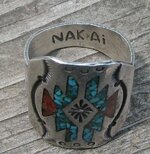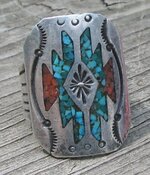Navigation
Install the app
How to install the app on iOS
Follow along with the video below to see how to install our site as a web app on your home screen.
Note: This feature may not be available in some browsers.
More options
You are using an out of date browser. It may not display this or other websites correctly.
You should upgrade or use an alternative browser.
You should upgrade or use an alternative browser.
Biggest and favorite silver ring to date!
- Thread starter swolfe
- Start date

John_Deere
Hero Member
- Mar 7, 2013
- 600
- 193
- Detector(s) used
- Personal: Bounty Hunter Gold Digger
Family: White's Coinmaster
- Primary Interest:
- All Treasure Hunting
Man, that thing looks like a monster! How someone loses something that big is beyond me. Congrats and HH!
Argentium
Gold Member
- Feb 2, 2008
- 9,058
- 5,575
- Detector(s) used
- Whites, MXT.
- Primary Interest:
- All Treasure Hunting
That's a nice find to be sure ! Nakai is/was Navajo , and the ring was most likely made in New Mexico or Arizona - circa 1970
wvwildman
Silver Member
- Jan 3, 2013
- 2,975
- 772
- Detector(s) used
- Garrett AT PRO, 5X8 DD, white's coin master pro, 4X6 DD, garrett propointer
- Primary Interest:
- Metal Detecting
nice find congrats HH
swolfe
Full Member
- Jul 8, 2012
- 219
- 437
- 🏆 Honorable Mentions:
- 1
- Detector(s) used
- Beep and Dig Harbor Freight 9 function detector.
Whites Coinmaster DB/4
Whites Coinmaster Pro
Tesoro Vaquero
Garrett AT Pro
- Primary Interest:
- Metal Detecting
- Thread starter
- #6
That's a nice find to be sure ! Nakai is/was Navajo , and the ring was most likely made in New Mexico or Arizona - circa 1970
hey thanks for the info

- Jan 6, 2006
- 20,845
- 2,532
- 🏆 Honorable Mentions:
- 1
- Detector(s) used
- Garrett AT Pro, Ace 250 & Ace 400
- Primary Interest:
- All Treasure Hunting
Beautiful! Love it!!
desert dog
Hero Member
- Oct 27, 2009
- 889
- 8
- Detector(s) used
- new coinmaster
- Primary Interest:
- All Treasure Hunting
wtg nice ring





prolab69
Bronze Member
- Oct 8, 2007
- 1,617
- 1,027
- Detector(s) used
- Whites Eagle Spectrum, Fisher CZ-3D
- Primary Interest:
- All Treasure Hunting
nice design, are those stones or just glass?
swolfe
Full Member
- Jul 8, 2012
- 219
- 437
- 🏆 Honorable Mentions:
- 1
- Detector(s) used
- Beep and Dig Harbor Freight 9 function detector.
Whites Coinmaster DB/4
Whites Coinmaster Pro
Tesoro Vaquero
Garrett AT Pro
- Primary Interest:
- Metal Detecting
- Thread starter
- #10
nice design, are those stones or just glass?
I'm not sure but it looks like a mosaic of tiny stones.
Erving
Hero Member
I like the ring a lot. Congrats. 
A little information on Grace and Gilo Nakai:
Signed Nakai Concho Buckle, Nine Conchos Inlay with Turquoise & Corral - $600 MARIN.
Signed Nakai Concho Buckle, Nine Conchos Inlay with Turquoise & Corral - $600 MARIN.
swolfe
Full Member
- Jul 8, 2012
- 219
- 437
- 🏆 Honorable Mentions:
- 1
- Detector(s) used
- Beep and Dig Harbor Freight 9 function detector.
Whites Coinmaster DB/4
Whites Coinmaster Pro
Tesoro Vaquero
Garrett AT Pro
- Primary Interest:
- Metal Detecting
- Thread starter
- #14
A little information on Grace and Gilo Nakai:
Signed Nakai Concho Buckle, Nine Conchos Inlay with Turquoise & Corral - $600 MARIN.
wow! that "bombing" process sounds cool. maybe in its prime my ring had a bit of value to it!
worldtalker
Gold Member
Nice lookin ring ya got here. GodBless Chris
wow! that "bombing" process sounds cool. maybe in its prime my ring had a bit of value to it!
Nakai is very collectable. If my better half had your ring for sale it would have a $75 price tag on it, maybe a little higher depending on the size and weight.
Argentium
Gold Member
- Feb 2, 2008
- 9,058
- 5,575
- Detector(s) used
- Whites, MXT.
- Primary Interest:
- All Treasure Hunting
In reply to questions about the colored chips used in the inlay on this ring and other chip/resin inlay jewelry of this vintage - Typically
the blue chips were comprised of crushed turquoise , the reds ideally would be coral - however it is possible that simulation coral ,
may be used here (plastics , or dyed alternative stone chips ) these chips are mixed with a resinous epoxy and put into the place
allotted for them . This chip inlay was quite popular from the 1950's thru the mid 70's in the south western U.S. and is associated
with Navajo and Zuni Native work primarily.
the blue chips were comprised of crushed turquoise , the reds ideally would be coral - however it is possible that simulation coral ,
may be used here (plastics , or dyed alternative stone chips ) these chips are mixed with a resinous epoxy and put into the place
allotted for them . This chip inlay was quite popular from the 1950's thru the mid 70's in the south western U.S. and is associated
with Navajo and Zuni Native work primarily.
Silver Slayer
Sr. Member
- Jun 19, 2010
- 413
- 166
- Detector(s) used
- Minelab Explorer SE Pro, XS, Minelab Excalibur Sea search, Fisher F2
- Primary Interest:
- All Treasure Hunting
Very Cool Ring!

swolfe
Full Member
- Jul 8, 2012
- 219
- 437
- 🏆 Honorable Mentions:
- 1
- Detector(s) used
- Beep and Dig Harbor Freight 9 function detector.
Whites Coinmaster DB/4
Whites Coinmaster Pro
Tesoro Vaquero
Garrett AT Pro
- Primary Interest:
- Metal Detecting
- Thread starter
- #20
In reply to questions about the colored chips used in the inlay on this ring and other chip/resin inlay jewelry of this vintage - Typically
the blue chips were comprised of crushed turquoise , the reds ideally would be coral - however it is possible that simulation coral ,
may be used here (plastics , or dyed alternative stone chips ) these chips are mixed with a resinous epoxy and put into the place
allotted for them . This chip inlay was quite popular from the 1950's thru the mid 70's in the south western U.S. and is associated
with Navajo and Zuni Native work primarily.
I'm learning a lot of stuff from one find, thanks

Top Member Reactions
-
 3420
3420 -
 2210
2210 -
 2040
2040 -
 1162
1162 -
 1039
1039 -
 987
987 -
 845
845 -
 810
810 -
 809
809 -
 772
772 -
 762
762 -
 619
619 -
 581
581 -
 567
567 -
 552
552 -
 452
452 -
 439
439 -
 430
430 -
E
419
-
 417
417
Users who are viewing this thread
Total: 2 (members: 0, guests: 2)





